For years now, BioWare has been a leading developer of role-playing games. Baldur's Gate, Neverwinter Nights, and Star Wars: Knights of the Old Republic are the company's claims to fame, and they've helped to galvanize a style of gaming that emphasizes open-ended storytelling and character development, as well as plenty of entertaining tactical combat. Yet despite having worked on definitive games like these for such a long time, only now has BioWare finally delivered an RPG that takes place in an original setting. But even though Jade Empire is set in a beautiful and exotic land inspired by the mythology of ancient China--seemingly a far cry from the medieval stylings of Dungeons & Dragons or the science fiction of Star Wars--the game is unmistakably similar to its predecessors. So fans of BioWare's past work will be in for a familiar experience, which, considering the company's very high standards, is great news. Sure enough, Jade Empire features a complex and interesting storyline, a number of great characters, an impressive presentation, and plenty of replay value.

With that said, the game also lacks the ambitious scope of, say, Knights of the Old Republic. It has the simplest design of any BioWare RPG yet, from the bare-bones character building elements to the action-based combat system. It's also surprisingly easy and fairly short by the genre's standards, offering up an adventure that shouldn't last you more than 20 hours on your first play-through. Presumably, all this is intended to be attractive to those who normally think role-playing games are too difficult or complicated to get into. Yet it's hard to imagine such players delving into Jade Empire's unusual world anyway, especially since it's filled with at least as much dialogue as action. In fact, one area in which BioWare definitely didn't skimp is the lengthy discussion sequences that feature the game's colorful characters. At any rate, fans of the company's previous efforts may be disappointed to find that Jade Empire is in some ways a step backward. While playing, it's hard not to wonder about exactly what the developer was intending to accomplish, since this overly streamlined design ends up leaving out a number of elements that made earlier BioWare RPGs deeper and more engaging by comparison. Fortunately, when you consider it on its own merits, Jade Empire is still a great game that offers a refreshing and memorable experience in spite of these shortcomings.
The eponymous setting of Jade Empire looks like it comes straight out of a spectacular martial arts action movie. Crouching Tiger, Hidden Dragon is the most obvious point of reference, though Jade Empire doesn't actually take place in ancient China, which gave the designers license to include a number of creative twists. For example, these ancient lands aren't entirely devoid of sophisticated technology, which includes armies of powerful automatons and rickety, bug-shaped flying vehicles that spew fire and smoke as they soar across the sky. As well, the Jade Empire has its fair share of supernatural problems. Vengeful ghosts walk the land, and all manner of demons (shaped like hulking toads, rats, elephants, and more) prey on hapless victims. In this rich setting, you play as a young martial artist on the verge of completing his or her training under one Master Li. Early on, an altercation with a bitter rival quickly escalates, and soon enough, you'll find yourself searching for Li and searching for answers. Along the way, you'll be joined in your quest by some interesting characters with great names like Sagacious Zu and The Black Whirlwind, as you uncover the truth behind your mysterious heritage and the evil spilling from the heart of the Empire. Jade Empire's plot actually seems fairly formulaic at first, but the story takes some clever turns and does a good job of tying up its loose ends.
As in Knights of the Old Republic, the main reason Jade Empire's story is so successful is that it gives you the sense that you have a great deal of influence over what happens. Dialogue with the game's dozens of characters is highly interactive, letting you choose from multiple responses whenever your character is prompted. Entire, fairly large portions of the game are optional, and certain significant outcomes are mutually exclusive. So you'll never see everything the game has to offer if you only play through it once. For example, one of the first big quests involves a small town that's in trouble because a nearby dam has been opened. The town will be saved if the dam could only be shut. But a certain unscrupulous merchant would prefer it if that didn't occur...that way he can keep the business of all the sailors stuck in harbor. Further complicating matters, you learn that the area on the other side of the dam is a burial ground for some restless spirits. Should you see if you can do something about them, or should you close the dam without delay, flooding them in? Or maybe you should side with the merchant and get a cut of his profits. Whatever you decide, the game offers a plausible outcome, as well as just desserts. The typical role-playing game on consoles presents you with a noninteractive story that you just sit back and watch, in between grinding through enemy encounters. Jade Empire is completely different from that blueprint, because it makes the story a central part of the gameplay itself. It sure is nice to actually get to role-play in a role-playing game, and the quality of the storytelling definitely doesn't suffer for it. The script is sharply written and finds the occasion for a few pretty funny jokes and references amid an otherwise serious plot.
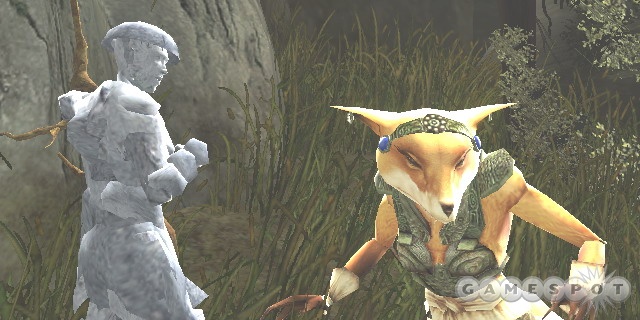
The sheer volume of different outcomes throughout the game is impressive, lending Jade Empire most of its replay value. It's possible to play the part of the selfless hero (while "selflessly" earning experience points for your troubles) or the arrogant villain, or shades in between. Granted, this is pretty much identical to what you got in Knights of the Old Republic, though your ability to veer toward the light or dark side of the Force in that game is thinly veiled as "the way of the open palm" and "the way of the closed fist" here. Considering that Jade Empire attempts to espouse a moral philosophy that's slightly more complex than, or at least different from, the conventional Western interpretations of good and evil, it's kind of a shame that character interaction still tends to boil down to the familiar extremes. There are some minor gameplay differences in being a good guy versus being a bad guy in that certain martial arts abilities and items are exclusive to disciples of one "way" or the other. This encourages you to at least be consistent, and it tends to be obvious in which direction a given response or action will nudge your character's alignment.
When you're not speaking with all the different characters you'll meet, you'll be running from place to place, often getting into fights. An annotated onscreen mini-map makes it fairly easy to get your bearings in the different regions, though none of these regions is particularly large anyway. There's actually not much to do in the environments apart from admiring the admittedly pretty scenery and cracking open the odd barrel or vase to scrounge whatever bit of loot is inside. Tellingly, the game lets you trigger "focus mode" at the touch of a button, which causes your character to run very swiftly to alleviate time spent in transit. It's a convenient feature, but it literally lets you rush through the game without stopping to appreciate any of the detail that must have gone into making the world look so good. The thing is, why stop and stare when there's nothing else to do? Jade Empire is considerably better-looking than Knights of the Old Republic, but its world isn't any more interactive, which is unfortunate, considering the flat feel of BioWare's previous game was one of its few shortcomings.
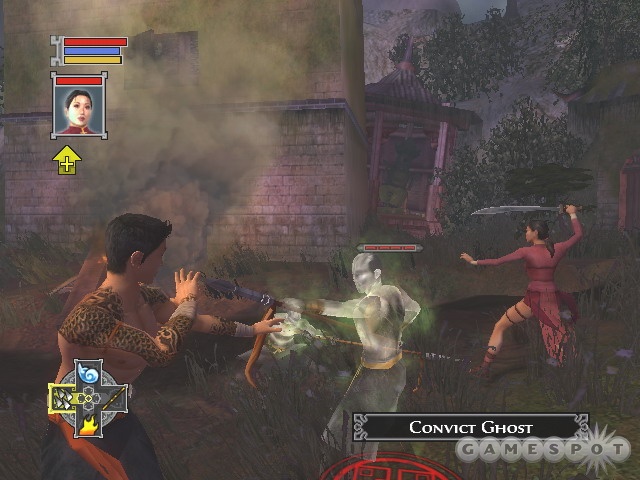
Then there's the combat. Most role-playing games (including all of BioWare's previous works) feature quasi-turn-based combat systems, which give you the opportunity to decide how your characters will respond to the dangers they're facing. But battles in Jade Empire play out in real time, like something you'd expect to see in an action game instead of an RPG. In general, you can have one companion fighting at your side, but you have no direct control over this character at all, which means you'll end up having to do most of the work yourself. All this is well and good, because Jade Empire's martial arts theme certainly seems conducive to action-packed combat.
However, Jade Empire's combat system isn't that great. It can be pretty fun, especially if you go out of your way to introduce more variety than you really need to survive, but it ultimately feels hollow. At least the controls are responsive, letting you easily maneuver around the battlefield, lock on to any of the foes you're facing, and execute quick flips and rolls either to close the distance between you and your opponent or to make a hasty retreat. It's possible to have four different martial arts styles (with names like "Leaping Tiger," "Storm Dragon," and "Thousand Cuts") mapped to your D pad, though all the styles you've learned are always there for you to choose from. There are five different types of styles, including standard hand-to-hand "martial" styles, weapons styles, and support styles, which cause debilitating effects instead of damage. Some enemies are immune to certain types of styles (for instance, ghosts are immune to weapons), so you're forced to mix it up a little.
There's not a lot to each style, though. You can execute a basic attack combo by mashing on the A button, you can perform a slow-but-unblockable attack by pressing X, and you can pull off an area-effect attack to sweep nearby enemies off their feet by pushing both those buttons at the same time. That's it. There are no throws, no counter moves, no high-flying wire fu, or any of that cool stuff. So, in practice, most battles work like this: You get close to an enemy and start pushing A. When the enemy blocks (which isn't often), you press X. If the enemy attacks, you vault over him with button B...and repeat as necessary. This same strategy works on literally every enemy in the game, from the least powerful to the most powerful.
While that's really all you need to know to save the Jade Empire, thankfully there's more to the game's combat system. For instance, you can link together moves from different styles to pull off powerful "harmonic combos," which can kill an enemy instantly and sometimes messily. And the fighting does get more complicated when you're facing a half-dozen enemies at once, including foes with ranged magical attacks. You'll also notice that the delays in your combo strings can be canceled either by quickly switching to one of your other styles or by using one of your evasive maneuvers in mid-combo, which helps give the action a fairly smooth, fluid feel. As you defeat enemies, you'll also notice that they sometimes drop power-ups that can restore your health, chi (used for healing yourself, as well as for magic attacks), or focus (used for weapon styles and your superspeed ability). All this stuff certainly helps flesh the fighting system out a bit.
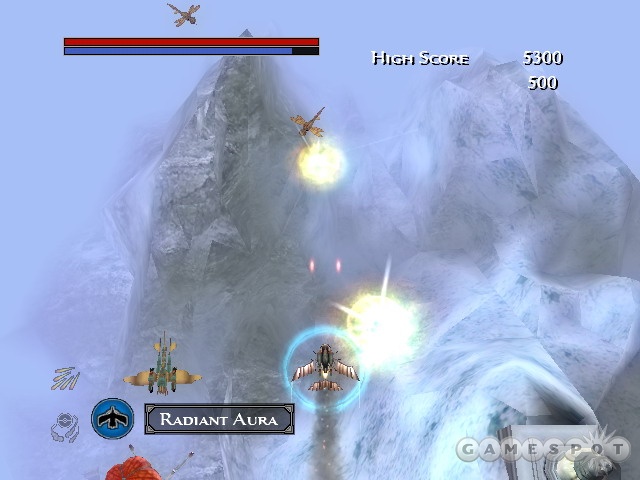
And yet, the predictable enemy behavior and the presence of some ridiculously overpowered styles, which can leave most foes frozen and unable to defend themselves, means that Jade Empire's combat devolves into routine. At the default difficulty setting, the combat also happens to be a total breeze, except for a few moderately difficult encounters against the toughest villains. There's a harder difficulty setting that you can switch to any time you're not already in battle, which makes the game a lot more punishing by making foes substantially stronger and harder to kill. At least the combat seems more plausible at the tougher setting, since it requires you to actually pay attention to survive the average encounter. Still, there's just no good middle ground between the two difficulty settings. Apart from Jade Empire's one minigame (an homage to vertical-scrolling shoot-'em-ups like Raiden and Ikaruga, but much choppier and nowhere near as good), the combat system is the only type of action you'll experience. So, despite being a source of fun and excitement as you play, the fighting is also the weakest link in a role-playing game whose combat conceivably could have been its main attraction.
When you level up (from gaining enough experience through questing and combat), you can improve the stats that boost your maximum health, chi, and focus. You also earn points with which you can bolster your different fighting styles, though it'll be pretty obvious how best to spend them. These enhancements have only a marginal effect on your character, so in time, you'll realize there isn't much of a payoff for leveling up. There isn't much of a payoff for attempting to develop your character in other ways, either. There's no real inventory system in Jade Empire, for example. You have a special amulet that can be equipped with gems that boost some of your stats, but that's it. These gems are often doled out as quest rewards, but their incremental improvements to your character aren't very satisfying. You'll also sometimes learn "techniques," which are simply permanent changes to your character's stats. Again, these mostly aren't a big deal. Since Jade Empire's combat is action-oriented, it's less about the sort of number crunching that goes on underneath the hood in other RPGs. So it devalues the entire process of gaining experience levels. And the lack of any cool stuff to buy devalues all the currency you'll be earning throughout your adventure. Fortunately, you'll be picking up new traveling companions and new fighting styles pretty consistently throughout Jade Empire, which takes some of the pressure off the oversimplified character advancement.
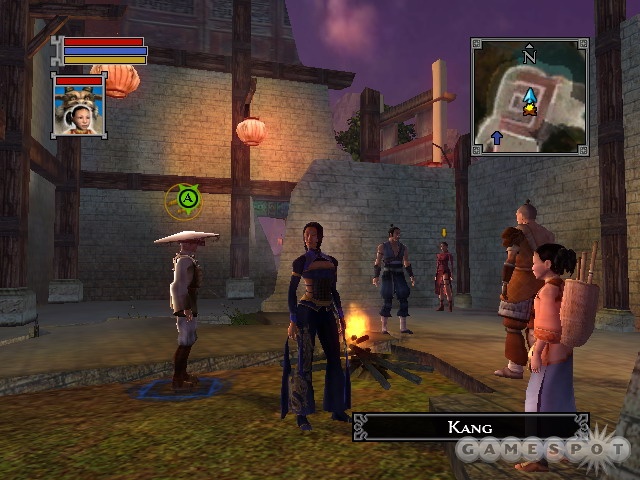
Jade Empire is unquestionably superior to its predecessors as far as the quality of its visuals is concerned, though. The world is all basked in a warm, soft glow that totally nails the dreamlike, mythical feel that Jade Empire is clearly shooting for. There's quite a bit of variety to the environments, too, and impressive special effects abound. One of the best-looking areas of the game is the Imperial City, which is teeming with life, color, and energy. When you reach it, you'll truly feel like you've set foot in a majestic place. Yet as beautiful as the Jade Empire is, it's its people that are especially remarkable. Virtually all the dozens of characters you'll meet during the course of your adventure have unique likenesses, rendered in a distinct and consistent art style. Most of the characters look really great, especially since they lip-synch all their dialogue quite convincingly. They also emote fairly well, showing touches of humor or anger or sadness as they speak, although there's one particular animation (of the character sheepishly rubbing the back of his or her head) that not only looks bad, but also recycles way too often throughout the game. Jade Empire also generally looks great during the action sequences, thanks to some convincing-looking fighting moves and some occasional surprising scenes of gore. The use of gore is perhaps telling of the game's tentative design, since most fights are bloodless, rather tame-looking affairs, despite the predominance of edged weapons. And yet, you'll sometimes get to see these huge, brutal gouts of blood spew forth from killed foes. It's no surprise the game got saddled with an M rating for its occasional outpourings.
A few technical hiccups hurt the presentation and overall experience. Jade Empire's frame rate is uneven, and it's prone to unsightly fluctuations at inopportune times. The game noticeably bogs down when multiple enemies are onscreen, and it sometimes seizes up for a moment when enemies are killed. These issues seem like holdovers from Knights of the Old Republic, which had similar problems. Jade Empire also has some painfully long loading times for when you transition between regions or between the shooter minigame and standard gameplay. It's too bad the loading times have gotten worse instead of better since the developer's last game. One of Jade Empire's most interesting side quests--one that focuses on your efforts to rise through the ranks of the Imperial Arena through a series of pit fights--exemplifies many of the game's strengths and weaknesses. On the one hand, there's some great stuff with the storyline here, including some amusing exchanges with a tongue-tied, spineless, yet likable fixer voiced by Brian Doyle-Murray. And on the other hand, practically every battle in the sequence is not only pitifully easy at the default setting, but also it's bookended by those long loading times. Despite these issues, it's still a great sequence, but it could have been a lot better.
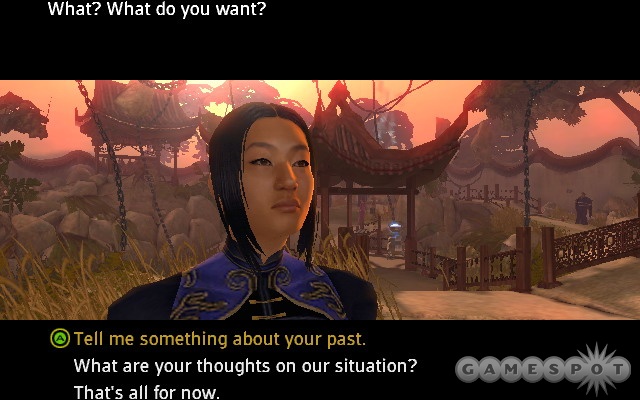
On the bright side, Jade Empire sure sounds terrific. Much like Knights of the Old Republic, what makes this game sound so impressive is the remarkable quantity of high-quality voice-overs you'll hear throughout. While it can be tempting to skip through the spoken dialogue because of the subtitles, some of the characters are voiced so well that you'll naturally prefer to hear them out. Not every character's performance is exceptional or anything, and some of the characters speak a made-up language called the Old Tongue, presumably because word-for-word voice-over wasn’t available. You’ll notice that sometimes these lines will repeat, and sometimes the voice inflection doesn't fit the dialogue when these lines are delivered. But so what? Few games offer the audio quality you'll find here. Jade Empire's actual sound effects (during combat and such) are fine, if not particularly outstanding. And its musical score, filled with strings, woodwinds, and deep percussion, is a perfect fit for the setting.
You'll probably enjoy Jade Empire a great deal if you approach it with reasonable expectations. Namely, you shouldn't expect a game that's hands-down superior to what you may have experienced from BioWare in the past. Instead, you can look forward to a game whose strengths ultimately outweigh its weaknesses by a long shot. In short, if the setting of Jade Empire appeals to you, along with the promise of a good storyline and some open-ended role playing, then you'll be more than satisfied with BioWare's latest game.